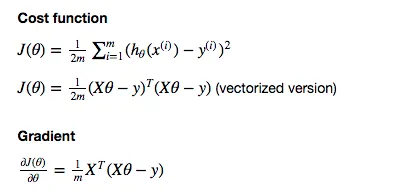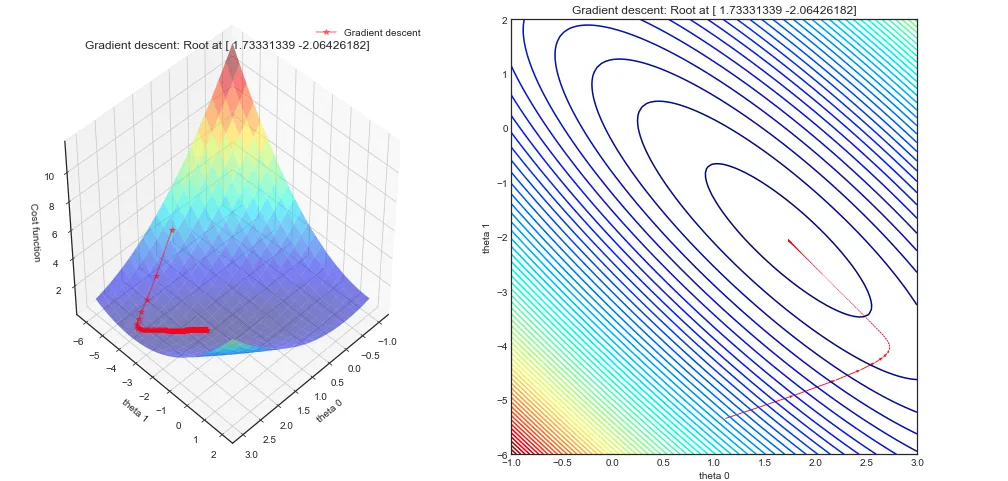作为自学练习,我正在尝试从头开始实现梯度下降算法解决线性回归问题,并在等高线图上绘制结果迭代过程。
我的梯度下降实现给出了正确的结果(已通过Sklearn测试),但是梯度下降图似乎不与等高线垂直。这是预期的还是我的代码/理解有误?
算法: 成本函数和梯度下降。
我的梯度下降实现给出了正确的结果(已通过Sklearn测试),但是梯度下降图似乎不与等高线垂直。这是预期的还是我的代码/理解有误?
算法: 成本函数和梯度下降。
import numpy as np
import pandas as pd
from matplotlib import pyplot as plt
from mpl_toolkits.mplot3d import Axes3D
def costfunction(X,y,theta):
m = np.size(y)
#Cost function in vectorized form
h = X @ theta
J = float((1./(2*m)) * (h - y).T @ (h - y));
return J;
def gradient_descent(X,y,theta,alpha = 0.0005,num_iters=1000):
#Initialisation of useful values
m = np.size(y)
J_history = np.zeros(num_iters)
theta_0_hist, theta_1_hist = [], [] #For plotting afterwards
for i in range(num_iters):
#Grad function in vectorized form
h = X @ theta
theta = theta - alpha * (1/m)* (X.T @ (h-y))
#Cost and intermediate values for each iteration
J_history[i] = costfunction(X,y,theta)
theta_0_hist.append(theta[0,0])
theta_1_hist.append(theta[1,0])
return theta,J_history, theta_0_hist, theta_1_hist
情节
#Creating the dataset (as previously)
x = np.linspace(0,1,40)
noise = 1*np.random.uniform( size = 40)
y = np.sin(x * 1.5 * np.pi )
y_noise = (y + noise).reshape(-1,1)
X = np.vstack((np.ones(len(x)),x)).T
#Setup of meshgrid of theta values
T0, T1 = np.meshgrid(np.linspace(-1,3,100),np.linspace(-6,2,100))
#Computing the cost function for each theta combination
zs = np.array( [costfunction(X, y_noise.reshape(-1,1),np.array([t0,t1]).reshape(-1,1))
for t0, t1 in zip(np.ravel(T0), np.ravel(T1)) ] )
#Reshaping the cost values
Z = zs.reshape(T0.shape)
#Computing the gradient descent
theta_result,J_history, theta_0, theta_1 = gradient_descent(X,y_noise,np.array([0,-6]).reshape(-1,1),alpha = 0.3,num_iters=1000)
#Angles needed for quiver plot
anglesx = np.array(theta_0)[1:] - np.array(theta_0)[:-1]
anglesy = np.array(theta_1)[1:] - np.array(theta_1)[:-1]
%matplotlib inline
fig = plt.figure(figsize = (16,8))
#Surface plot
ax = fig.add_subplot(1, 2, 1, projection='3d')
ax.plot_surface(T0, T1, Z, rstride = 5, cstride = 5, cmap = 'jet', alpha=0.5)
ax.plot(theta_0,theta_1,J_history, marker = '*', color = 'r', alpha = .4, label = 'Gradient descent')
ax.set_xlabel('theta 0')
ax.set_ylabel('theta 1')
ax.set_zlabel('Cost function')
ax.set_title('Gradient descent: Root at {}'.format(theta_result.ravel()))
ax.view_init(45, 45)
#Contour plot
ax = fig.add_subplot(1, 2, 2)
ax.contour(T0, T1, Z, 70, cmap = 'jet')
ax.quiver(theta_0[:-1], theta_1[:-1], anglesx, anglesy, scale_units = 'xy', angles = 'xy', scale = 1, color = 'r', alpha = .9)
plt.show()
表面和轮廓图
评论
我的理解是,梯度下降法垂直地沿着等高线进行。这不是这样吗?谢谢。

